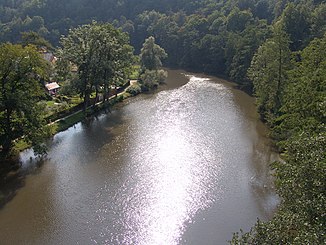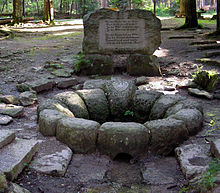Eger (Elbe)
|
Eger Ohře |
||
|
Egerschleife in Loket |
||
| Data | ||
| Water code | DE : 532, CZ : 1-13-01-001 | |
| location | in Germany ( Bavaria ) and in the Czech Republic | |
| River system | Elbe | |
| Drain over | Elbe → North Sea | |
| River basin district | Elbe | |
| source | in the Fichtelgebirge 50 ° 4 ′ 28 ″ N , 11 ° 49 ′ 33 ″ E |
|
| Source height | 752 m above sea level NN | |
| muzzle | in Litoměřice in the Elbe Coordinates: 50 ° 31 ′ 43 " N , 14 ° 8 ′ 9" E 50 ° 31 ′ 43 " N , 14 ° 8 ′ 9" E |
|
| Mouth height | 136 m nm | |
| Height difference | 616 m | |
| Bottom slope | 1.9 ‰ | |
| length | 316 km | |
| Catchment area | 5614 km² | |
| Drain |
MQ |
37.34 m³ / s |
| Left tributaries | Selbbach , Silberbach , Großbach , Slatinný potok . Fleißenbach , Libocký potok , Zwodau , Rolava , Bystřice , Hutná , Chomutovka , Rosovka | |
| Right tributaries | Röslau , Buchbach , Wondreb , Teplá , Lomnice , Liboc , Blšanka | |
| Medium-sized cities | Cheb , Sokolov , Karlovy Vary | |
|
Course of the Eger in Northern Bohemia |
||
The Eger ( Czech Ohře ) is a left tributary of the Elbe in Germany and the Czech Republic . It rises near Weißenstadt in the Fichtelgebirge and flows into the Elbe near Litoměřice (German Leitmeritz ).
Surname
The German name of the water body has Indo-European roots: The developed Germanic preform * Agriā has roughly the meaning of 'the strong flowing, wild river'.
With the immigration of the Slavs into the area populated by Teutons, the name of the water was taken over from them. It is borrowed from the West Slavic and transformed through sound shift in a spoken in Alttschechisch Ohře . This name had its own development in the Czech language and has remained constant in today's phonetic form since the 13th century. Its roots, like the German name, go back to the Indo-European era.
course
The most important source stream of the "Old Eger" is the Zinnbach . It rises on the northern slope of the Schneeberg in the Fichtelgebirge. Another spring was marked with a memorial stone in 1850 to make it easier to reach. Since then, this has been the official source of Eger. The river takes its course to the east, reaches the Czech border after 60 km near Hohenberg an der Eger and is on a short section of the border river before it finally flows into the Czech Republic .
The largest city on the upper reaches of the Eger is Cheb (German: Eger), below the Skalka dam on the Bavarian border. The next hundred kilometers the Eger flows south of the Ore Mountains through the Eger Basin to the northeast; 40 km northeast of Eger it passes Karlsbad , which is located in the Falkenau basin . The spa is also the largest city on the Eger. As far as Kadaň (German: Kaaden) the river flows through the narrow valley called Egergraben , which separates the Ore Mountains (Czech: Krušné hory ) from the Duppauer Gebirge (Czech: Doupovské hory ). The river is then dammed in the Kadaň and Nechranice dams .
It crosses the North Bohemian Basin and flows south of the Central Bohemian Uplands (Czech: České středohoří ) into the Elbe . Well-known cities on this section are Žatec (German: Saaz), Louny (German: Laun), Libochovice and Terezín (German: Theresienstadt).
Egerquelle
The source of the Eger spring (not to be confused with the Eger origin in Baden-Württemberg) is located on the north-west slope of the Schneeberg , 150 m west of the district road WUN 1 Weißenstadt - Bischofsgrün ; Egerquelle car park. The source can also be reached on the FGV main hiking trail Quellenweg . For a long time a simple stone with the inscription "Egerquelle 1850" was enough. The current version of the spring from 1923 (inaugurated in 1924) goes back to the initiative of the Bohemian city of Eger . Immediately south of the spring socket, a rectangular granite block rests on two stone cubes with the inscription:
Inscription of the source text of Eger
When the boy came to Eger:
"? Eger, say where you hurry back"
"At the same," it roars brisk,
"At the same I must zieh'n"
When the boy came to the Elbe ,
the answer was content-heavy;
Thundering back the same roars:
"And I have to go into the German sea!"
The slightly modified text comes from the song Podersamer Heimatklänge . A memorial stone of the Sudeten German expellees from 1955 is only a few meters to the side of the source. The spring area with its hardwood environment is a protected natural monument. The headwaters of the Old Eger are located south of the Weißenhaider Mühle on the northern slope of the Schneeberg. This is where the actual Egerlauf, now called Zinnbach, is said to have its origin. The easier-to-reach current source has been taken for convenience.
Tributaries
- Selbbach (Czech: Račí potok )
- Silberbach
- Großbach (Czech: Libský potok )
- Röslau (Czech: Reslava )
- Buchbach (Czech: Výhledský potok )
- Schladabach (Czech: Slatinný potok )
- Fleißenbach (Czech: Plesná )
- Wondreb (Czech: Odrava )
- Leibitschbach (Czech: Libocký potok , eastern border of the historical Egerland)
- Zwota (Czech: Svatava )
- Rolava (German: Rohlau )
- Teplá (German: Tepl )
- Lomnice (German Lomnitz )
- Bystřice (German: Wistritz )
- Prunéřovský potok (German: Brunnersdorfer Bach )
- Liboc (German: Aubach )
- Hutná (German: Saubach )
- Blšanka (German: Goldbach )
- Chomutovka (German: Assigbach )
- Rosovka
- Hasina
- Smolnický potok
Drain
- Transfer system Podkrušnohorský přivaděč (left) near Klášterec nad Ohří to Bílina
Hans-Heiling-Felsen between Loket and Karlsbad
The Eger in Karlsbad (Karlovy Vary)
Klášterec nad Ohří Castle (Monasteries on the Eger)
Estuary into the Elbe shortly after Terezín (Theresienstadt), opposite Litoměřice (Leitmeritz)
See also
Individual evidence
- ↑ a b Karlheinz Hengst : Why is Eger called Ohře as a river and Cheb as a city? In: Erzgebirgische Heimatblätter 35 (2013) 1, pp. 3–5, ISSN 0232-6078
- ^ Text: Karl Tilp; Setting: Josef Freyer ( Memento of the original from February 21, 2014 in the Internet Archive ) Info: The archive link was automatically inserted and has not yet been checked. Please check the original and archive link according to the instructions and then remove this notice. ; MID ; (2 kB)
literature
- Johann Kaspar Bundschuh : Eger . In: Geographical Statistical-Topographical Lexicon of Franconia . tape 1 : A-egg . Verlag der Stettinische Buchhandlung, Ulm 1799, DNB 790364298 , OCLC 833753073 , Sp. 695-696 ( digitized version ).
- Dietmar Herrmann, Helmut Süssmann: Fichtel Mountains, Bavarian Vogtland, Steinwald, Bayreuther Land. Lexicon . Ackermannverlag, Hof (Saale) 2000, ISBN 3-929364-18-2 , The Egerquelle.
- Jaroslav Michálek, Petr Uhlík: The Eger - a remarkable river . Krajské Muzeum, Sokolov 2006, ISBN 80-86630-11-0








